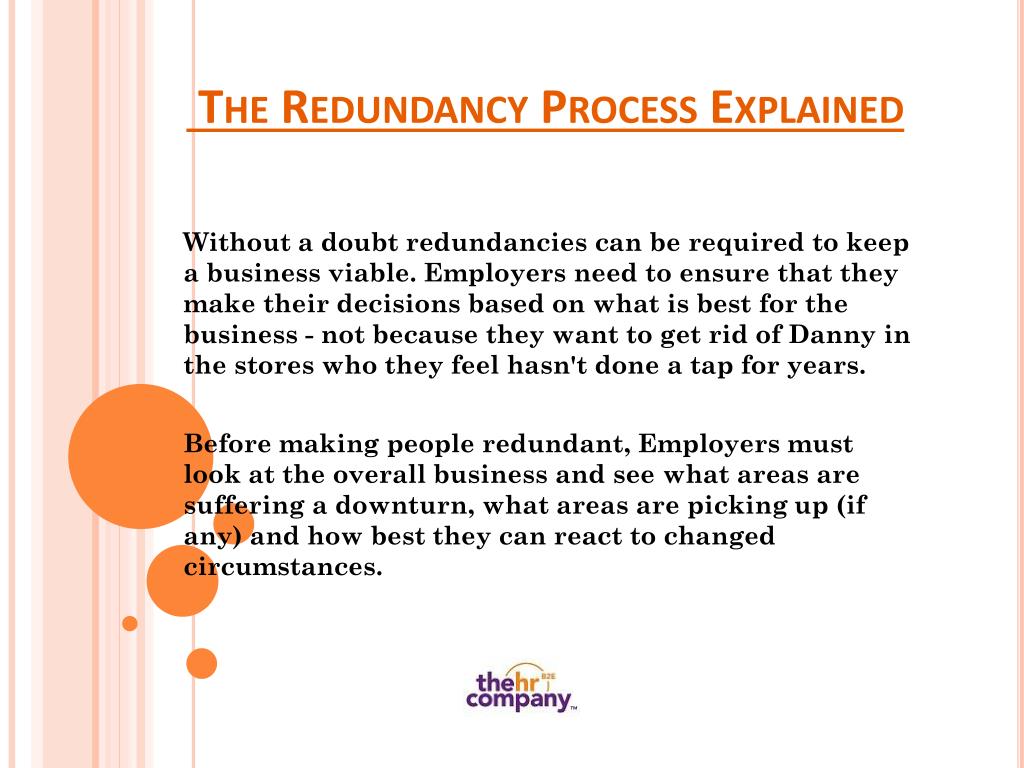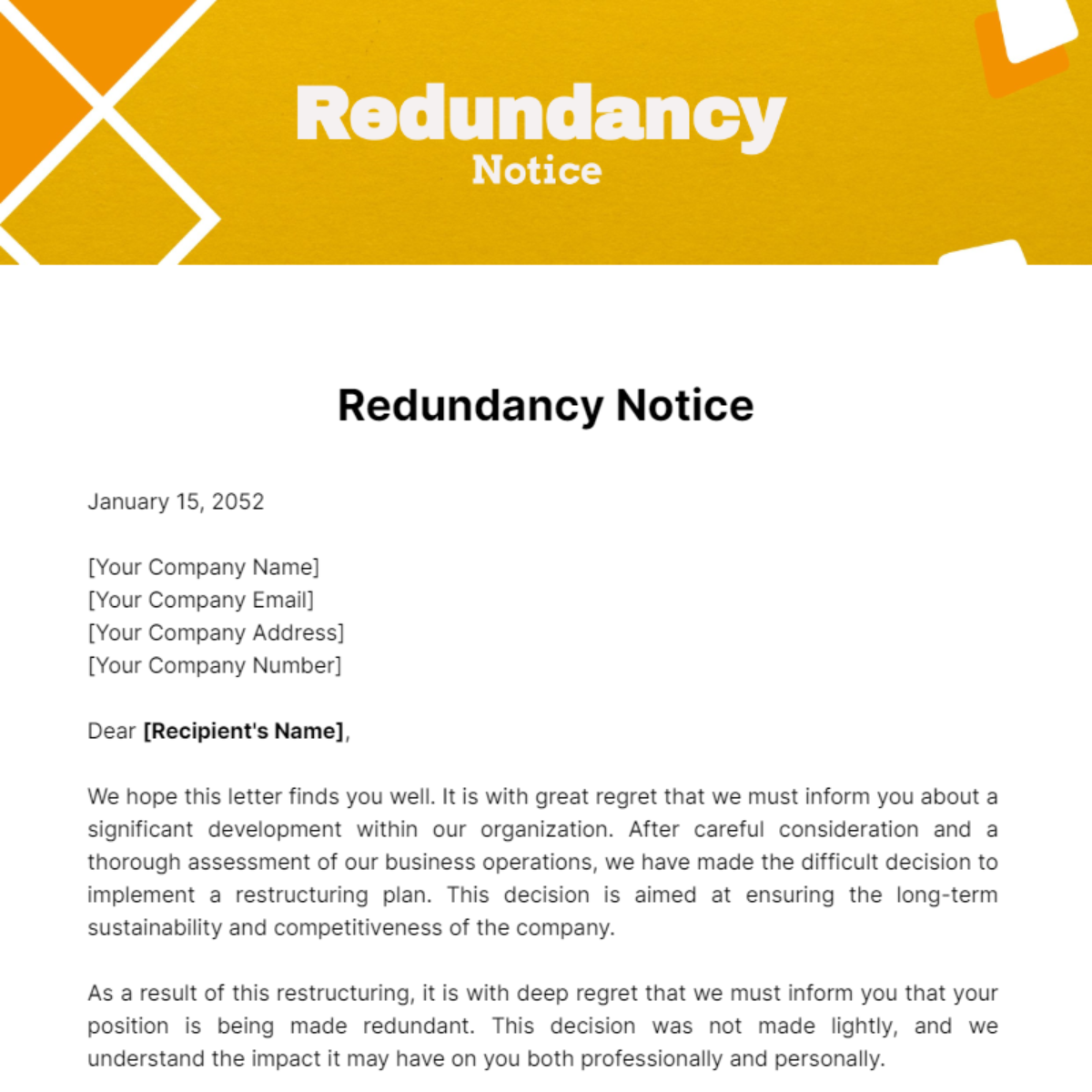Small Business Closing Employee Rights UK: What You Need to Learn About Redundancy
Small Business Closing Employee Rights UK: What You Need to Learn About Redundancy
Blog Article
Checking Out the Interplay Between Business Redundancy and Organizational Flexibility for Future Growth
In the dynamic landscape of today's organization globe, the detailed partnership between business redundancy and organizational versatility arises as a critical factor for sustained development and success. Firms often face the obstacle of striking a delicate balance between preserving a degree of redundancy to minimize dangers and promoting versatility to react promptly to the ever-evolving market needs.
Relevance of Company Redundancy
Company redundancy is an essential element that enhances organizational durability and reduces operational dangers. By integrating redundancy steps within the organizational framework, companies can much better endure unanticipated interruptions and variations in business setting. Redundancy offers as a critical barrier, enabling business to adapt and respond effectively to unforeseen challenges without endangering essential procedures.
One trick element of the significance of company redundancy is its function in guaranteeing continuity throughout times of situation. When faced with sudden changes or emergency situations, redundant systems, sources, or employees can step in to maintain crucial features and stop widespread disturbances. This connection not only safeguards the business's track record and customer trust yet additionally minimizes monetary losses and functional downtime.

Techniques for Business Versatility

An additional essential method is purchasing modern technology and infrastructure that can support flexibility and scalability. Carrying out electronic devices, automation, and information analytics can simplify procedures, boost efficiency, and provide important insights for informed decision-making. Furthermore, producing adaptable organizational structures that enable quick adjustments to market dynamics and customer needs is important for staying competitive in a rapidly evolving environment. By proactively identifying potential disturbances and possibilities, companies can proactively adjust and flourish in an ever-changing company landscape.
Harmonizing Redundancy and Versatility
Accomplishing a harmonious stability between functional redundancy and business adaptability is extremely important in browsing the complexities of a vibrant company setting. Redundancy within a business offers a safety and security internet, guaranteeing connection and stability in procedures. Nevertheless, an unwanted of redundancy can cause ineffectiveness and prevent versatility to changing market problems. On the various other hand, organizational flexibility enables companies to respond without delay to external disturbances and seize brand-new opportunities. Striking the ideal balance between redundancy and flexibility is a delicate procedure that needs a deep understanding of the organization's objectives, industry dynamics, and threat tolerance.
To attain this equilibrium, firms require to conduct routine analyses of their procedures to determine areas where redundancy is essential for threat reduction and where flexibility can drive technology and development. Applying adaptable frameworks, cultivating a society of constant discovering and enhancement, and motivating open communication across all levels of the company are vital approaches to balance redundancy and versatility efficiently. By aligning these two critical components, firms can place themselves for sustainable growth and success in an ever-changing organization landscape.
Instance Research Studies on Adaptation Success
In analyzing instances of effective organizational adaptation, it comes to be obvious that the interplay between functional redundancy and versatility is a defining consider forming resilient organizations. One engaging case research is that of Netflix. At first a DVD rental service, Netflix showed amazing adaptability by transitioning right into a streaming platform when digitalization interfered with the market. By strategically spending in technology and web content development, Netflix not only flourished yet made it through in a rapidly progressing market. Another standout instance is Amazon. Beginning as an on the internet book shop, Amazon constantly adjusted its company version, expanding right into diverse markets such as cloud computer and expert system. This flexibility permitted Amazon to stay ahead of competitors and fulfill changing customer needs. Lastly, Adobe supplies a noteworthy picture of effective adjustment. The company moved from marketing software licenses to a subscription-based design, making certain repeating profits streams and boosted customer interaction. These instance studies underscore the relevance of functional redundancy coupled with organizational versatility in promoting lasting development and competitiveness.
Building Resilience for Future Growth
Structure strength for future development needs a calculated positioning of operational processes with market dynamics and arising fads. Business need to adapt to changing environments by cultivating a society of versatility, development, and continuous improvement. Strength entails not only recuperating from setbacks but additionally proactively planning for future difficulties. One essential aspect of structure durability is investing in durable danger management methods to minimize possible disruptions. This includes situation planning, expanding supply chains, and developing backup prepare for numerous backups (who pays redundancy money).
In addition, promoting solid connections with stakeholders, such as link consumers, employees, see it here distributors, and the community, is crucial for weathering uncertainties and keeping trust and assistance throughout rough times. Efficient interaction and transparency play a crucial role in building durability, as they aid align assumptions and promote collaboration in navigating unpredictabilities.
In addition, organizations need to focus on understanding and development initiatives to upskill staff members and outfit them with the required tools to adjust to transforming conditions. By purchasing their workforce, business can improve their flexibility and dexterity, ultimately strengthening their resilience for sustainable future growth.
Final Thought

In the dynamic landscape of today's organization world, the detailed relationship in between firm redundancy and organizational versatility arises as an important variable for sustained growth and success. Firms frequently deal with the obstacle of striking a delicate balance in between keeping a level of redundancy top article to reduce threats and cultivating adaptability to respond promptly to the ever-evolving market needs.To achieve this balance, business require to perform normal assessments of their operations to determine locations where redundancy is necessary for risk mitigation and where versatility can drive advancement and development.In verdict, the interplay between company redundancy and organizational versatility is important for future development. Structure strength via a mix of redundancy and flexibility will certainly ensure that companies are prepared for the challenges of the future.
Report this page